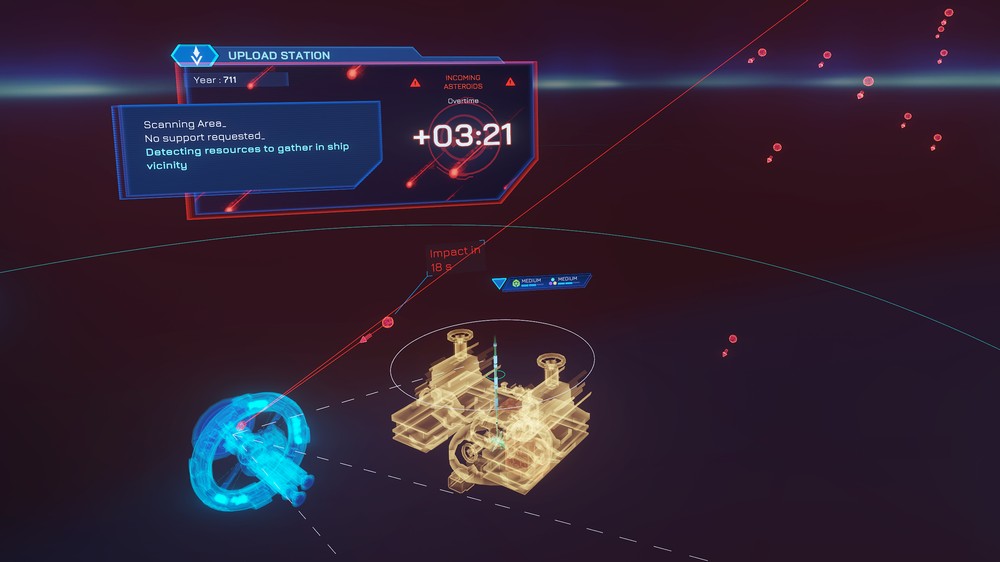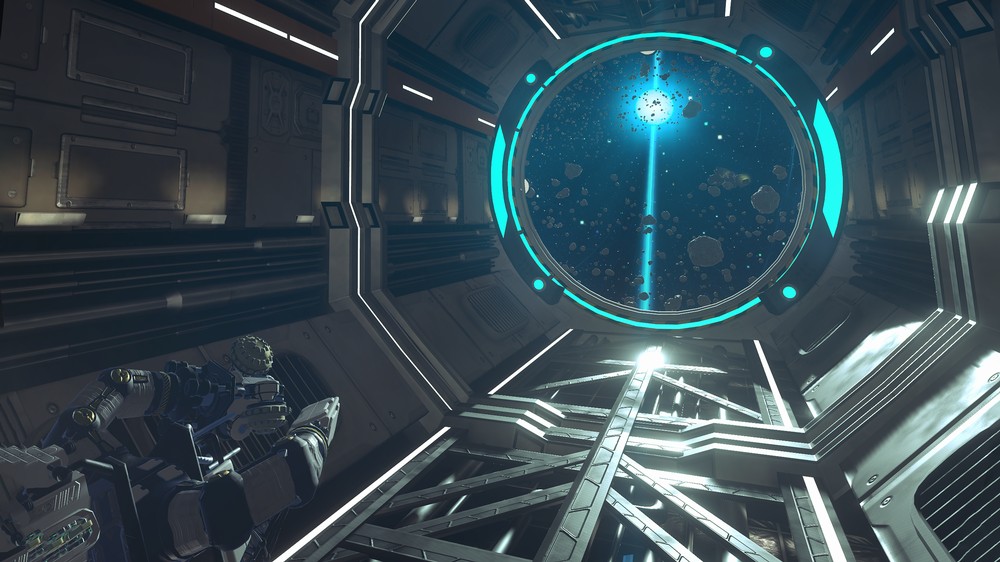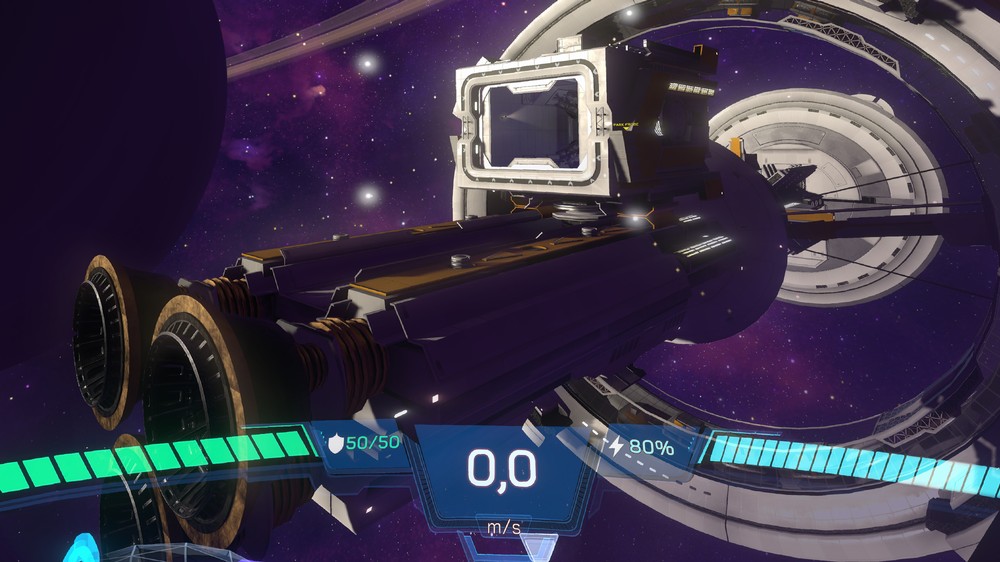About a year ago I was playing Watch Dogs 2 and there was this mission where I had to break into the San Francisco offices of Ubisoft and steal/leak/upload a trailer for their hot new game. That game was AGOS. I had no idea at the time that game within a game was real, or going to be real a year later, but it is and it’s here and I’m playing it. AGOS – A Game of Space has become my new passion, an addiction that even distracts from my new PS5. I tell myself I’m going to play just one or two missions and then it’s 4am and I’m plotting a course past Jupiter with 5,000 human survivors relying on me to keep the human race alive.
Ironically, I hated this game the first hour I played it. There was no opening, no explanations, no tutorial other than simple objectives and waypoints, but no instructions on how to use these holographic control spheres floating in front of me. I’m pretty good with space games and concepts of no inertia and principals of thrust and momentum, but nothing made sense. The game starts with me in orbit over Earth just as this massive ship parks over the planet with a meteor swarm not far behind. I am thrust behind the controls of this tiny space drone and tasked with unlocking the docking clamps holding a massive ark-like ship in orbit, a ship containing the last 5,000 survivors of the human race.
 Many hours later I feel like a chump even complaining about the controls. They seem so second nature to me now, and I can pilot my drone like a seasoned space captain, but there is a significant learning curve in adapting to the three-dimensional thinking required to play this game. You’ll spend nearly all your time controlling this small space drone that you can maneuver along X, Y, and Z axis using a combination of main thrusters and maneuvering jets. The trick here is to figure out the proper combination of propulsion options. Thrusters move you faster, but speed isn’t always a good thing since every object in motion requires an opposite reaction of equal force to cancel out. You also have a sphere for steering your ship in 3D space, and while pointing your drone in a certain direction has little bearing on navigation, later in the game you will have attachments that are direction specific.
Many hours later I feel like a chump even complaining about the controls. They seem so second nature to me now, and I can pilot my drone like a seasoned space captain, but there is a significant learning curve in adapting to the three-dimensional thinking required to play this game. You’ll spend nearly all your time controlling this small space drone that you can maneuver along X, Y, and Z axis using a combination of main thrusters and maneuvering jets. The trick here is to figure out the proper combination of propulsion options. Thrusters move you faster, but speed isn’t always a good thing since every object in motion requires an opposite reaction of equal force to cancel out. You also have a sphere for steering your ship in 3D space, and while pointing your drone in a certain direction has little bearing on navigation, later in the game you will have attachments that are direction specific.
To aid you in flying your drone your steering sphere will plot a line in the direction your probe will move unless otherwise acted upon. Once you kick in the thrusters another thicker line will appear showing your actual course based on any previous inertia. I found that using the brakes to stop all movement allowed for the easiest matching of plotted course and actual path of travel. You can also get knocked off course and even spin out of control if you come in contact with a random asteroid or a gas pocket erupts. I’ve even had a drill bit bite into a crystal wrong and send me spiraling out into space. You do need to monitor your probe damage levels as well as remaining fuel. If you run out of energy, you’ll need to limp back to the docking bay on reserve power.
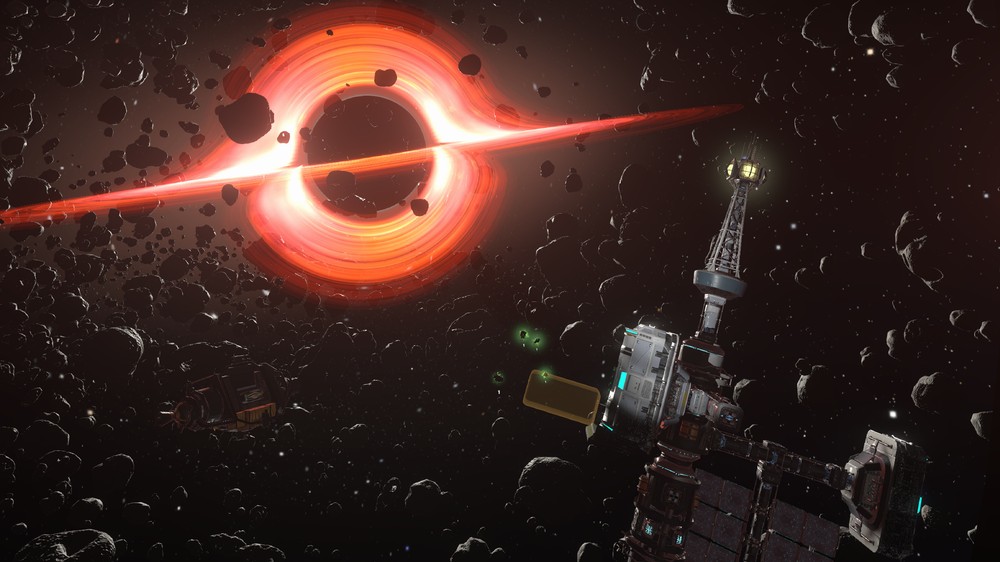 The core game loop is for you to get your ship and its passengers to safety. A few missions into the game you will learn that a black hole is consuming the solar system, so you get to plot your course around the planets as you spiral your way to a new life, but it’s a long trip and it’s going to require a lot of resources. Along the way you will make numerous stops where you’ll probe the area for resources such as fuel and minerals and even bits of data all used for an intricate crafting system. These resources show up as multi-colored glowing “gems” floating in space waiting to be collected by your drone. While many of these are simply floating around others need to be harvested from space clouds and gas jets and others need to be mined using a fancy drill bit. These accessories can be “purchased” from an unlockable tech tree using previously required resources as well as engine upgrades and even new probe models. Later, you can even upgrade the World Ship by attaching new pods to the various connection points to increase its capabilities.
The core game loop is for you to get your ship and its passengers to safety. A few missions into the game you will learn that a black hole is consuming the solar system, so you get to plot your course around the planets as you spiral your way to a new life, but it’s a long trip and it’s going to require a lot of resources. Along the way you will make numerous stops where you’ll probe the area for resources such as fuel and minerals and even bits of data all used for an intricate crafting system. These resources show up as multi-colored glowing “gems” floating in space waiting to be collected by your drone. While many of these are simply floating around others need to be harvested from space clouds and gas jets and others need to be mined using a fancy drill bit. These accessories can be “purchased” from an unlockable tech tree using previously required resources as well as engine upgrades and even new probe models. Later, you can even upgrade the World Ship by attaching new pods to the various connection points to increase its capabilities.
The layer of systems is really quite brilliant and helps keep the game from getting too monotonous. In later levels you’ll find more resources than you can carry on a single trip, so you will need to make several, often switching out probe tips for specific acquisitions. A mission map indicates what tools you might need, and not everything happens in space. You will come across the occasional space station that you can fly inside and explore for additional resources. These interior sections require some precise flying and are often dark with your only spotlight facing forward. You’ll even encounter other ships where you can trade for rare items.
 The visuals are quite stunning in some places, mostly in the menus and the crafting and upgrade screens. The map screen allows you to grab, spin, and zoom around a holographic map of the galaxy or just the part you happen to stop in. Everything is tactile, so to start a mission you have to grab your probe and drag it to the mother ship dock then grab it from there to launch. Meanwhile your immediate surroundings such as asteroid clumps or perhaps the wreckage of an old space ship are also on this amazing 3D transparent map. In the galaxy map you can see all your favorite planets spinning around the sun as you chart your course across the solar system, all the while this big black hole is looming on the outer edge. The detail level goes into ultra-mode when you are dealing with the probe or the world ship. Being able to grasp and bring these objects right up to your face reveals just as much detail as if ILM had built real models and you were actually holding them. The main habitation ring around the mother ship is transparent allowing you to see inside where there are all these trees and living quarters. There are thrusters and individual parts and panels on these ships, and crafting attachments creates new 3D parts that you can attach or pull apart just like you are building your own physical model.
The visuals are quite stunning in some places, mostly in the menus and the crafting and upgrade screens. The map screen allows you to grab, spin, and zoom around a holographic map of the galaxy or just the part you happen to stop in. Everything is tactile, so to start a mission you have to grab your probe and drag it to the mother ship dock then grab it from there to launch. Meanwhile your immediate surroundings such as asteroid clumps or perhaps the wreckage of an old space ship are also on this amazing 3D transparent map. In the galaxy map you can see all your favorite planets spinning around the sun as you chart your course across the solar system, all the while this big black hole is looming on the outer edge. The detail level goes into ultra-mode when you are dealing with the probe or the world ship. Being able to grasp and bring these objects right up to your face reveals just as much detail as if ILM had built real models and you were actually holding them. The main habitation ring around the mother ship is transparent allowing you to see inside where there are all these trees and living quarters. There are thrusters and individual parts and panels on these ships, and crafting attachments creates new 3D parts that you can attach or pull apart just like you are building your own physical model.
AGOS – A Game of Space is a slow burn with the first several hours having no real threat, just casual exploration and resource gathering, but later on threats will get introduced, one of the first being an impending meteor swarm that puts you on a time limit for getting the job done. There are a lot of quality-of-life features like automatic checkpoints and multiple game slots so the entire family can play their own games. The relative static nature of your position within the game along with the slow-moving drift of the space probe creates a very comfortable situation for VR. Camera control is manual and you’ll feel like an orchestra conductor as you squeeze the camera buttons on each controller and move your hands around to spin the camera around the probe. You can always click the button to position in behind the drone, but this also assumes you are facing in your direction of travel.
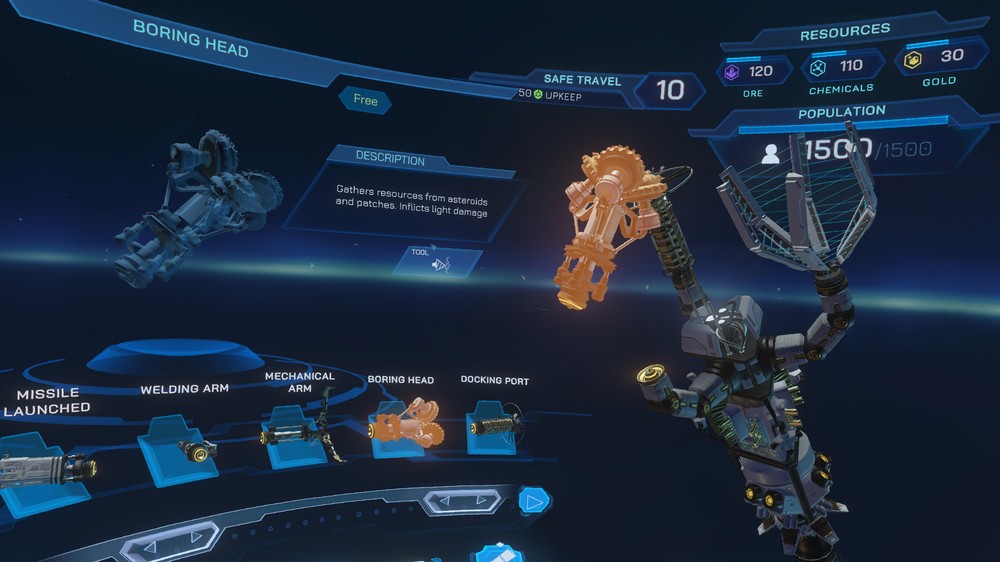 The audio portion of the game is hauntingly ethereal, leaving you to revel in the silent majesty of space. Composer, Austin Wintory has crafted a pleasing soundtrack worthy of the sci-fi material being presented, but sound effects are minimal; the hiss of a jet, the roar of a thruster, or the metallic bang when you bounce off an asteroid. Considering there is no sound in space I’m happy to hear anything. There is no speech, narration, or computer voice, and only minimal story material found in data logs you can download. There is a lot of quality gameplay with none of the trappings to keep you emotionally invested in the outcome other than to simply win. It seems there may have been greater plans for AGOS and then somebody just rushed it out the door. The fact this game released with little fanfare seems a bit odd.
The audio portion of the game is hauntingly ethereal, leaving you to revel in the silent majesty of space. Composer, Austin Wintory has crafted a pleasing soundtrack worthy of the sci-fi material being presented, but sound effects are minimal; the hiss of a jet, the roar of a thruster, or the metallic bang when you bounce off an asteroid. Considering there is no sound in space I’m happy to hear anything. There is no speech, narration, or computer voice, and only minimal story material found in data logs you can download. There is a lot of quality gameplay with none of the trappings to keep you emotionally invested in the outcome other than to simply win. It seems there may have been greater plans for AGOS and then somebody just rushed it out the door. The fact this game released with little fanfare seems a bit odd.
While AGOS – A Game of Space can be played on the Vive or the Rift I chose to only play this on my Rift S. The game is played seated, so room scale is unnecessary, and the Touch controllers are so much more comfortable for long- session games like this. I started the game on my RTX2080ti card and midway through switched to the RTX3080 and was able to crank the rendering resolution to 150%, which made the game super-sharp and super-detailed. There was still a bit of model deformation as ships and asteroids snapped into a cleaner look the closer you got, but the draw distance was fantastic with glowing collectibles being visible at over 1400m away.
AGOS is a must-own, must-play game for anyone who loves space and owns a VR headset. I was worried this was going to be like all the other space station simulators out there, but it’s not. This is totally original and totally awesome with a fun flying mechanic for collecting resources and a fantastic crafting and upgrade system that took me back to my teens building plastic models in my bedroom. The game does have a few issues including a very poor first impression and steep learning curve, but once you figure things out, you’ll never want to stop playing. This is easily one of the best VR games of 2020.


